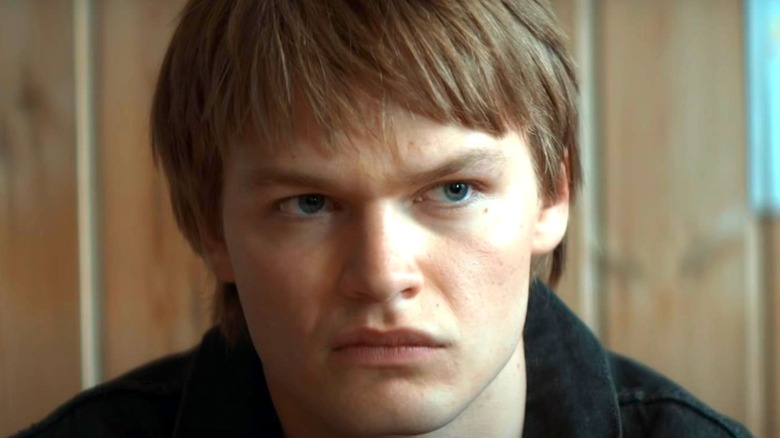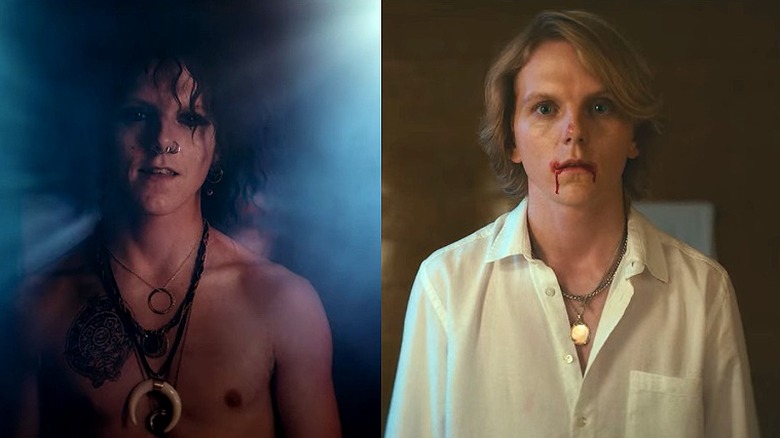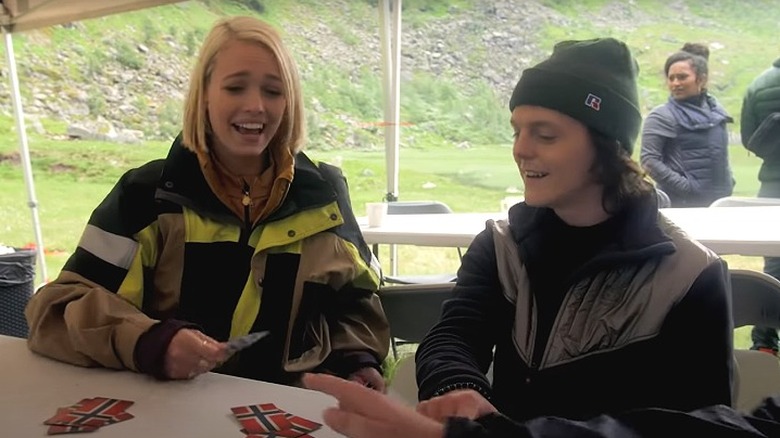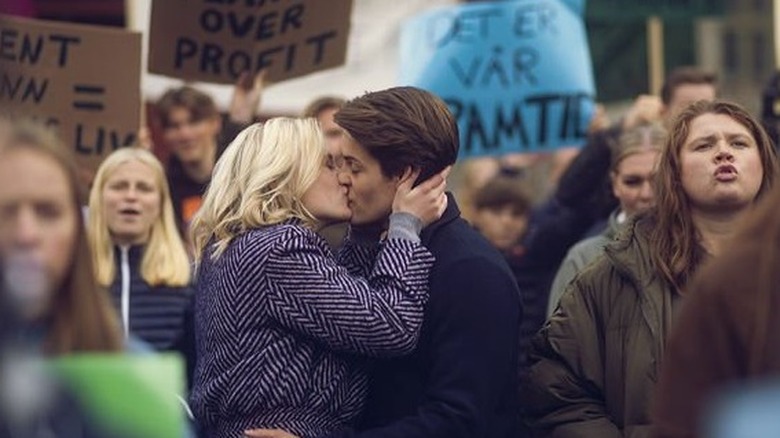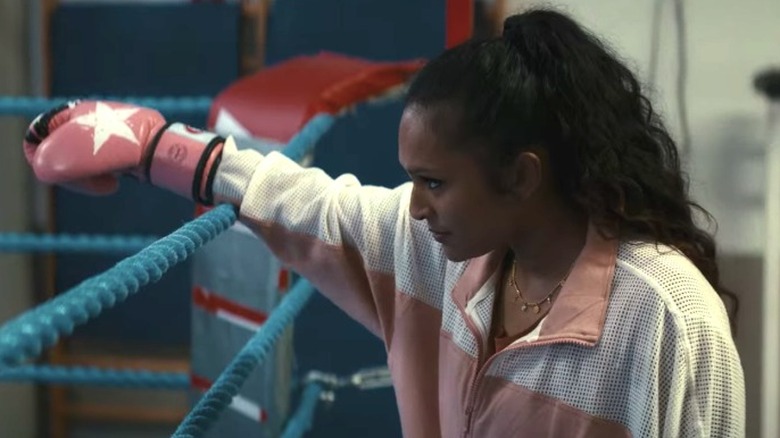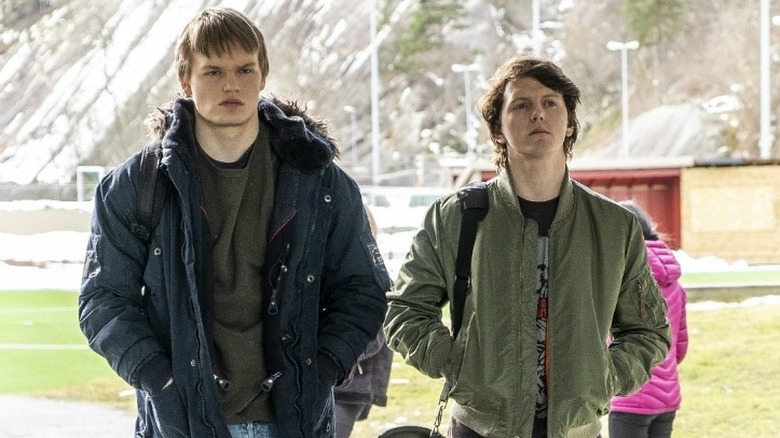The Untold Truth Of Ragnarok
Netflix's Norwegian television series "Ragnarok" (no relation to "Thor: Ragnarok") garnered the attention and devoted following of fans around the globe, and not just for its painfully hip, Karen O and Cult of Y-laced soundtrack or the swoon-worthy, avant-garde wardrobe donned by its wealthier characters. Created by Danish writer, director, and producer Adam Price with a storyline by Emilie Lebech Kaae, the six-episode first season hit Netflix in January of 2020 and was followed up by a second six-episode season in May of 2021.
The series follows brothers and New Kids in Town Magne (David Stakston) and Laurits (Jonas Strand Gravli) as they and their widowed mother Turid (Henriette Steenstrup) attempt to navigate their new home in the small Norwegian village of Edda. The village is dominated by a family of elite factory owners (who are actually ancient Frost Giants, as well as giants of capitalism), and both Magne and Laurits develop superhuman powers reminiscent of the Old Gods Thor and Loki, respectively.
What reads, on paper at least, like a cross between "Dawson's Creek" and the original "Mighty Morphin Power Rangers" is actually a contemporarily relevant adaptation of 13th century writer Snorri Sturluson's Prose and Poetic Eddas, AKA the first written source of Norse mythology in existence. "Ragnarok" tackles some serious themes for a show about teens, including climate change (its main focus), gender and sexual identity, income inequality, and corporate greed. Its seamless weaving of the ancient poems and tales into twenty-first century characters and storylines has earned it some serious street cred (see: CBR's thoughts on the matter) but there's even more to this fascinating series than you might think.
Ragnarok is as much about identity as it is about mythology
Believe it or not, the MCU didn't invent the notion that Loki is genderfluid entity, and neither did Stan Lee nor the creators of "Ragnarok." As Spencer McDaniel explains in an article for Tales of Times Forgotten, "Loki has always been what a modern person would describe as genderfluid — even in the original Norse myths...in one Old Norse poem, Loki is said to have lived on earth as a woman...had sex with a man, and gave birth to children."
To update the ancient source for the modern era, Price and Lebech Kaae had Loki's reincarnation — high school student and mischievous brother Laurits — grapple with his own gender identity and sexuality. In Season 2, Laurits asks his teacher how he interprets Loki giving birth to the Midgard Serpent, and if that makes them "the first trans person in history," to which his teacher replies, "Yeah. I guess you could say that." Laurits is also struggling to accept that he's actually Magne's half brother and that his father is corporate mogul and secret Frost Giant Vidar Jutul (Gísli Örn Garðarsson).
Laurits isn't the only character investigating his identity. Magne worries that he may be Thor (or, based on his name, Thor's son Magni) reincarnated, while Fjor Jutul (Herman Tømmeraas) is torn between his allegiance to his wealthy Frost Giant family and his love for the blue collar and all-too-human Gry (Emma Bones). Finally, Saxa Jutul (Theresa Frostad Eggesbø) struggles to accept her role in the Jutul's dynamic and corporation. Although she's more capable than her brother of running the company in their father's stead, the fact that she's female places her at the bottom of the Frost Giant ranks. Saxa and Magne, though enemies, find some common ground in their mutual family conflicts, which leads to further identity crises for both characters.
The cast of Ragnarok lived together during filming
"Ragnarok" was filmed on location in Odda, Norway (a name the show's creators changed to "Edda"), and although its a Norwegian Netflix production, the series cast actors from all over Scandinavia and Europe. Moreover, its production company, SAM productions, is Danish, as are its co-writers (Emilie Lebech Kaae and Adam Price) and its directors (Jannik Johansen, Mogens Hagedorn, and Mads Kamp Thulstrup). The vast majority of the "Ragnarok" team had to travel quite a distance for the series, and subsequently stayed in the same hotel in the village for nearly five months. "We don't have trailers," series star Herman Tømmeraas notes in an episode of "The Making of Ragnarok," (available on Nordic Netflix via YouTube) "but we have popcorn!"
By all appearances, the cast and crew's proximity to one another helped them form the off-camera bonds and relationships necessary for on-screen dynamics to thrive. Synnøve Macody Lund — who plays Frost Giant, high school principal, and corporate powerhouse Nan — explained that the cast hung out together all the time, and another cast member likened the experience to summer camp. In one episode of "The Making of Ragnarok," real-life pals and on-screen brothers Jonas Strand Gravli and David Stakston revealed that, on occasion, the language barrier amongst the diverse team became a source of some hilarious misunderstandings. Speaking about one of the show's Danish directors (it's not clear which), Stakston shared that he asked a group of extras to "'grine.'" In Danish, the word means "laugh," but in Norwegian, it means "to cry." "Everyone was like...sh**. Crying on cue," Stakston laughed, before jokingly asking Gravli if he could do it, and if he wanted to practice (via YouTube).
Language hiccups, inclement weather, and crowded quarters notwithstanding, both "The Making of Ragnarok" and the actors' realistic interactions suggest the series only benefitted from its unconventional set.
Ragnarok tackles real world socioeconomic and environmental issues
While it's easy to think of the progressive country as a beacon for environmental awareness, the series makes it clear that there is indeed "something rotten in (Norway)." Although the country has done more than most others to protect against environmental hazards, it has a hard time getting around the fact that — despite its own lack of dependence on non-renewable resources — it's largest export is crude petroleum and petroleum gas (via The OEC).
Recently, The Lonely Planet reported that its strong stance on Arctic pollution "is undermined by its production of fossil fuels" and the repeated exemptions for companies that harvest them. In addition to breaking down Norway's economic dependence on some of the threats it seeks to defend against, the article reports that Norway's "annual level of household waste generated per person has nearly doubled...a rise that coincides with the golden years of Norway's oil-fueled prosperity boom."
"Ragnarok" uses these issues as the basis for its narrative's action (in fact, the series puts forth the idea that Ragnarok itself will be brought on by human-created climate change). When Magne and Gry must write a paper on Edda, they're warned to make sure their thesis isn't about how "it's only old white men who are destroying the world and causing all the ice to melt."
Gry rejects this demand, and in an episode titled "We Love this Country," she delivers a compelling speech, saying, "We have pollution, the ice is melting, people lie sick at home, but nobody talks about that." But like so many other Norwegian villages, she explains, the citizens are economically reliant on "the same sh*** factory." In "Ragnarok," the 'haves' own the factories, and the 'have-nots' drink the toxic water they produce to put food on the table.
Ragnarok has almost nothing in common with the MCU (and is better off for it)
Aside from the whole Norse mythology "thing," Netflix's "Ragnarok" and Marvel's "Thor" franchise have about as much in common as the United States' and Norway's disparate approaches to health care. While the MCU focuses namely on the battle between Loki (Tom Hiddleston) and Thor (Chris Hemsworth) for control over Asgard, and concerns itself predominantly with the Order vs Chaos themes of the mythology that inspired Stan Lee, "Ragnarok" is interested in something else. Their plots differ wildly, and in the battle of "Ragnarok" vs "Thor: Ragnarok," the mission itself is entirely different.
Unlike the MCU's ever-expanding spin on these stories, "Ragnarok" balances the epic with the intimate, putting itself in a more immediate conversation with its source material. The ancient Norse created these stories to explain "the epic," (e.g., the creation and destruction of the world) but they also created characters and storylines to whom they could relate, and through which they could see and better understand themselves. Thor and Loki may have been immensely powerful beings, but they were also just two members of a complicated family dynamic (in the mythology, they're not brothers, but they do have the most on-again-off-again relationship), who represented mankind's idealism and righteousness as much as its pragmatism and inner conflict.
The gods and their stories and dynamics allegorically reflected those of their human creators, and many of their tales have nothing to do with saving the universe or claiming a throne. In scaling these tales and conflicts down to a coming-of-age narrative, "Ragnarok" is able to highlight and embrace this connection to Norse mythology, whereas Marvel is simply too epic to get its big, giant Thanos hands around the more nuanced psychology behind these characters.
Ragnarok speaks to the anxieties of today's youth
None of this is to say that Marvel's iteration of Thor is lacking. It's important to remember that the MCU's source material isn't actually The Poetic and Prose Eddas, but the comic book series created by Stan Lee. Moreover, in creating "Loki" for Disney+, Marvel allowed itself some time and space to investigate the more intimate motivations of (arguably) its most interesting antagonist. Nonetheless, there is something both refreshing and more practically inspiring in seeing such complex and seemingly distanced mythology play out in, for instance, a widowed mother's struggle to raise her two sons, a high schooler coming to terms with both their gender and their sexuality, or a teenager's determination to — naive as it sounds — effect real change in the world.
When Magne first meets Iman (AKA Freya, played by Danu Sunth) at gym class, he tells her, "this place is f****** up, just so you know," to which she responds, casually, "then maybe we could change that." In "Ragnarok," Adam Price has accomplished exactly what he set out to do. "There are a lot of people today," he explained in an interview at the show's premiere, "not least of all young people, who think the world is...on the brink of an apocalypse...I figured that people in this world need something to put their faith in...there is a need for a tale of a hero" (via YouTube).
Although the ever-growing popularity of superhero franchises and spin-offs demonstrates this need, Price's decision to ground his hero's tale in a setting and context to which many young people can relate — and on an immediate, literal level at that — does something of which superhero mega blockbusters are rarely capable. It puts itself in a direct and relevant conversation with both its ancient source material, and its twenty-first century audience.
